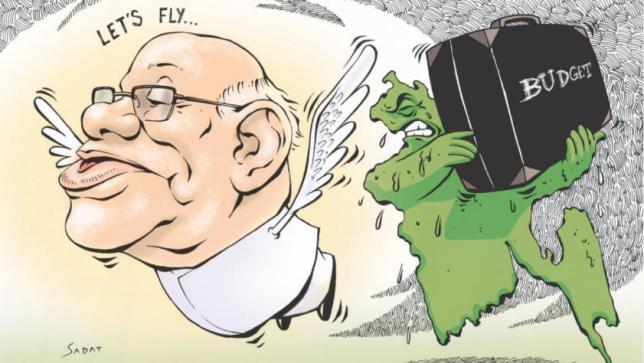Published in The Daily Star on Friday, 8 June 2018
 The national budget is a means to manage the economy of a country through collection of revenue from various sources and making expenditures for development programmes. Hence, budget, though planned for only one fiscal year, has a direct impact on people. Budgetary allocations and policy incentives can also help achieve long-term goals.
The national budget is a means to manage the economy of a country through collection of revenue from various sources and making expenditures for development programmes. Hence, budget, though planned for only one fiscal year, has a direct impact on people. Budgetary allocations and policy incentives can also help achieve long-term goals.
Fiscal Year 2018 comes to a close with lacklustre economic growth, a somewhat subdued average annual inflation rate and high export and remittance income. However, the economy is caught up with several challenges that cast a shadow on its positive achievements. Firstly, strong growth of Gross Domestic Product (GDP) has been confined within the rhetoric of numbers. The quality of GDP growth is under question since growth could not benefit all. The employability of this growth has been low which is manifested through low job creation as a whole, and high unemployment rate among the educated youth of the country. Moreover, growth has not been able to generate adequate income for decent living for a large section of people. Second, the achievement of budgetary targets of revenue generation and expenditure efforts remains unfulfilled. This makes the fiscal framework weak, a feature common in all fiscal years. Third, inflation is ticking up gradually, mainly through high food inflation. Fourth, a large current account deficit due to higher import payments has resulted in a negative balance of payment despite high export and remittance growth. Fifth, cluttered with large amounts of non-performing loans (NPL), the banking sector remains a troubled one in the economy.
In this context, the budget for FY2019 presents a new set of targets. On the macro fiscal policy stance, the government has kept the budget deficit at 4.9 percent, only a minimal decline from the usual 5 percent. Maintaining such a target has never been a problem for the government as expenditure targets are not fulfilled. Higher reliance on bank borrowing is observed to meet up with the budget deficit in FY2019. Given the exceedingly high purchases of savings certificate in FY2018, bank borrowing is the obvious choice. However, when the government is trying to improve the liquidity situation of commercial banks through various supports, what will be the impact on future liquidity due to high dependency on bank borrowing is something to be observed.
 The size of the budget for FY2019 is 18.3 percent of GDP for FY2019. This is not a big amount given the size of Bangladesh’s population and requirement for development programmes. The size of previous year’s budget (FY 2018) has been revised downward to 16.6 percent of GDP. And undoubtedly, the actual size of budget will be even lower than the revised budget, if the past trend provides us any guidance. In the same tune, the size of the Annual Development Programme (ADP) is set to be 6.8 percent of GDP while the growth of ADP is projected to be 16.6 percent in FY2019. ADP implementation was lower during July-April in FY2018 compared to FY2017. Low physical progress undermines the quality of overall ADP implementation. Several projects are declared as completed projects without 100 percent physical progress.
The size of the budget for FY2019 is 18.3 percent of GDP for FY2019. This is not a big amount given the size of Bangladesh’s population and requirement for development programmes. The size of previous year’s budget (FY 2018) has been revised downward to 16.6 percent of GDP. And undoubtedly, the actual size of budget will be even lower than the revised budget, if the past trend provides us any guidance. In the same tune, the size of the Annual Development Programme (ADP) is set to be 6.8 percent of GDP while the growth of ADP is projected to be 16.6 percent in FY2019. ADP implementation was lower during July-April in FY2018 compared to FY2017. Low physical progress undermines the quality of overall ADP implementation. Several projects are declared as completed projects without 100 percent physical progress.
In order to meet the proposed expenditure, the revenue target has been set at 30.8 percent higher in FY2019 than that of FY2018. The mismatch between revenue mobilisation target and actual achievement has become a common feature of the budget. Against a lower than targeted revenue collection, the revenue-GDP rate has been slashed down to 11.6 in the revised budget of FY2018 which may be even lower in the actual budget of FY2018. Ironically, revenue-GDP ratio was only 10.2 percent against the target of 13.5 percent for FY2017 as laid out in the Seventh Five Year Plan (7FYP). At the current pace of revenue generation effort, the target of 7FYP in FY2020 will not be fulfilled. Thus the capacity of budget implementation comes to the fore while discussing the budget for FY2019. Lower budget deficit may provide fiscal space, however, the space is not fulfilled by higher development expenditure.
In his expenditure proposals, the finance minister has expanded the social protection coverage. It has been proposed that both the number of beneficiaries and amount of allowances be increased. This is a praiseworthy step. The allocation for social security has been increased to 2.53 percent of GDP from 2.17 of GDP in the revised budget of FY2018. However, this social security allocation also includes pension for retired government employees and their families. Excluding this pension, allocation for social security comes to around 1.6 percent of GDP, which is quite low compared to the requirement.
Spending on physical infrastructure is crucial for faster economic growth. Accordingly, the budget has more resources for the transport and power sectors. However, social infrastructure is yet to receive adequate allocation. For example, the 7FYP targets an expenditure of 2.84 percent of GDP in FY2019 while the announced budget sets it at 2.1 percent of GDP. Of the total allocation for education, 31.2 percent constitutes wages, salaries and administrative expenses. Despite the emphasis on the quality of education, only 1.4 percent of total allocation for education is provided for training.
As for the fiscal measure, re-imposition of 25 percent customs duty and 3 percent regulatory duty on rice import will protect the local farmers who are distressed due to low price of their production. Some other measures such as lower tax for readymade garments having green building certification, higher increasing supplementary duty on cigarette and bidi paper and on production of polythene and plastic bags are positive measures.
However, tax free income threshold for individuals remained unchanged at Tk 2.50 lakh though the inflation rate has increased. An important tax measure in this budget is the reduction of tax for publicly traded bank, insurance and financial institutions from 40 percent to 37.5 percent and for non-publicly traded bank, insurance and financial institution from 42.5 percent to 40 percent. When the banking sector is in a mess due to various irregularities, the budget speech does not talk about how the performance of the sector should be improved. Such tax incentive is a continuation of various supports provided to the banking sector in the recent past. All these are to help maximise profits of the owners, ignoring the larger interest of the common people in getting better services. Nothing is mentioned in the budget speech as to what reforms will be undertaken to solve the ongoing crisis in the banking sector.
Budget for FY2019 is the last budget of the current political government. With the national elections fast approaching, this is also an election budget. However, the budget could not provide much enthusiasm among the broader sections of the people in terms of meeting some of their desires. On the whole, budget for FY2019 has not provided any guidance towards sound macroeconomic and fiscal management.
Fahmida Khatun is the Executive Director of Centre for Policy Dialogue (CPD).



